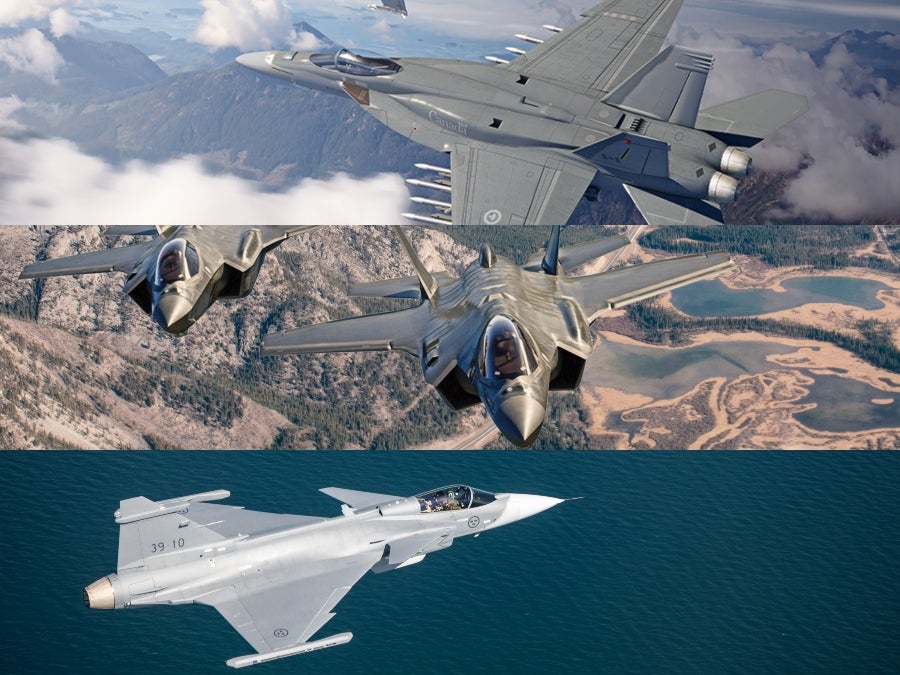
Dogfight for Canadian Skies: Saab, Lockheed Martin, Boeing Compete for Next Fighter Jet
In 2016, Canada’s Department of National Defence announced plans to replace its legacy fleet of CF-18 Hornets with a purchase of 88 fighter jets that will serve beyond 2060. Under the FFCP project, the first new fighters will be delivered in 2025, with interest in the competition now down to three contenders; Lockheed Martin, Boeing, and Saab.
Bid evaluation and selection are due in 2021 when the Canadian government will choose between Lockheed’s F-35, Boeing’s F/A-18 Super Hornet, and Saab’s Gripen E. Canada estimates that the purchase will be valued at C$15-19bn (US$11.3-14.3bn) for the aircraft and associated equipment.
Originally five companies were interested in the programme, but Dassault Aviation withdrew from the competition in 2018 Airbus withdrawing earlier this year, knocking out the Rafale and Typhoon.
Saab Gripen E
Saab’s bid for the Canadian fighter programme includes 88 Gripen E aircraft, along with a support and training package and what Saab called “an industrial and technological benefits programme.”
Saab business area Aeronautics head and senior vice president Jonas Hjelm commented on the offer of the Gripen E saying: “Saab’s Gripen fighter is designed to operate in harsh environments and defeat the most advanced global threats. The system meets all of Canada’s specific defence requirements, offering exceptional performance and advanced technical capabilities.
“A unique element of the avionics design is that Gripen E’s system can be updated quickly, maintaining technological superiority against any adversary,”

US Tariffs are shifting - will you react or anticipate?
Don’t let policy changes catch you off guard. Stay proactive with real-time data and expert analysis.
By GlobalDataKey to Saab’s industrial offer is that it will form a “Gripen for Canada Team” made up of Saab, IMP Aerospace & Defence, CAE, Peraton Canada and GE Aviation.
Hjelm added: “With Saab and Gripen, the Royal Canadian Air Force will have full control of its fighter system. A guarantee to share key technology, in-country production, support and through-life enhancements will ensure that Canada’s sovereignty is enhanced for decades.”
The Gripen E has been ordered by Sweden and Brazil, both of which have already received their first aircraft.
Lockheed Martin F-35
Commenting on Lockheed Martin’s F-35 offer, programme executive vice president Greg Ulmer said: “We are extremely proud of our longstanding partnership with Canada, which has played a key role in the F-35’s development.
“The fifth-generation F-35 would transform the Royal Canadian Air Force fleet and deliver the capabilities necessary to safeguard Canadian skies.”
Canada was an early player in the Joint Strike Fighter Programme, with Lockheed Martin saying an F-35A purchase would “continue to bring manufacturing and production opportunities to Canada” and support around 150,000 jobs throughout the life of the programme.
Ulmer added: “The F-35’s unique mix of stealth and sensor technology will enable the Royal Canadian Air Force to modernise their contribution to NORAD operations, ensure Arctic sovereignty and meet increasingly sophisticated global threats.”
As it stands nine countries, including the US, UK and Israel operate F-35 variants from home soil, with six services having deployed the aircraft on combat operations.
Lockheed Martin touts the use of the aircraft by the US, Denmark and Norway as benefits for Canada selecting the fighter from an interoperability standpoint when it comes to Arctic operations.
Boeing F/A-18 Super Hornet
Following the formal RFQ, Boeing Canada announced it had offered the F/A-18 Super Hornet Block III to the Royal Canadian Air Force calling the fighter “a proven, affordable choice”.
Commenting on the offer, Boeing Defense, Space & Security Canada Fighter Sales Director Jim Barnes said: “We have a partnership with Canada that spans more than 100 years. We don’t take that lightly. The response we submitted today builds upon that great legacy and allows us to continue to bring the best of Boeing to Canada and the best of Canada to Boeing.
“The Super Hornet is the most cost-effective and capable option for the FFCP, and a Super Hornet selection will help the RCAF meet their mission needs while leveraging existing infrastructure to drive down the long-term sustainment cost of the aircraft.”
Barnes added that the two-engine design of the Super Hornet meant it could operate in the harshest environments thrown at it. Boeing’s offer includes a “100% guaranteed industrial plan” which Barnes said would deliver well-paid jobs to the country over a long-term period.
Boeing added that selecting the fighter would bring “unparalleled, guaranteed opportunities” to Canadian industry.
The F/A-18 Super Hornet is currently in-service with the US Navy, Royal Australian Air Force and Kuwaiti Air Force, with the fighter, also being offered by Boeing for Finland’s HX Challenge to replace its current fleet of F/A-18C/D Hornets.
This year, Germany also announced its plans to acquire 30 Super Hornets as part of its mixed fleet replacement for the Panavia Tornado.



